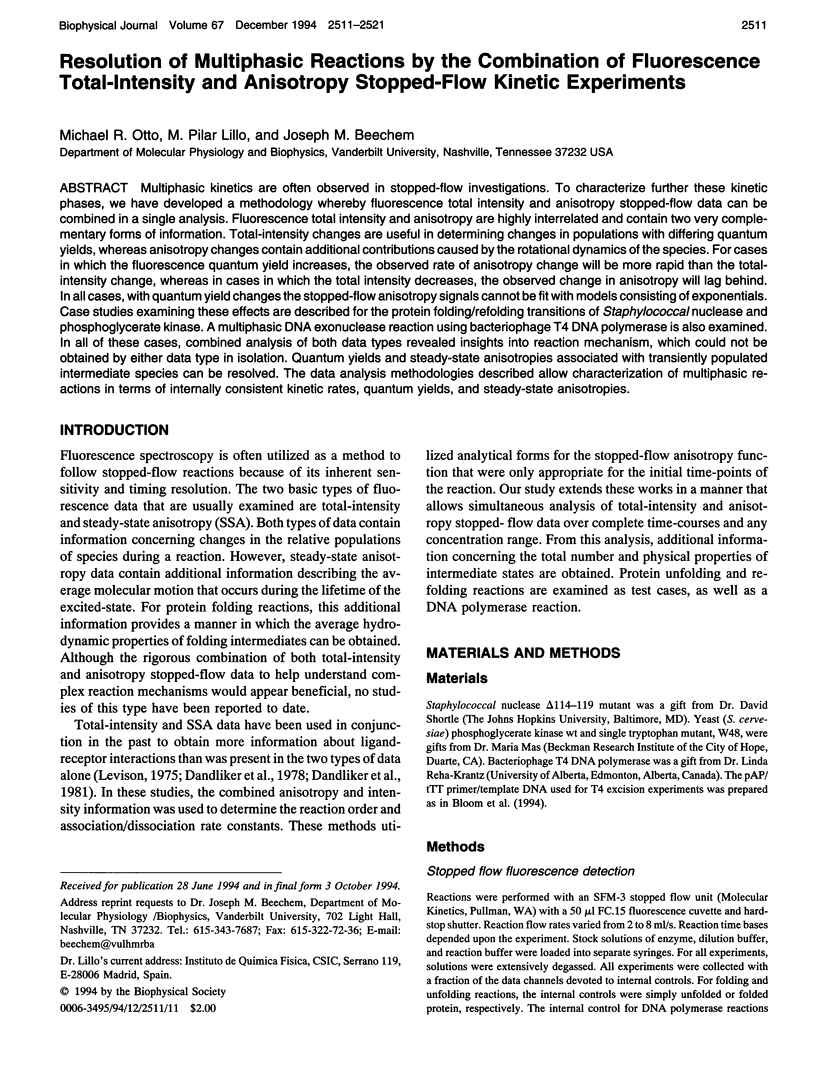Abstract
Multiphasic kinetics are often observed in stopped-flow investigations. To characterize further these kinetic phases, we have developed a methodology whereby fluorescence total intensity and anisotropy stopped-flow data can be combined in a single analysis. Fluorescence total intensity and anisotropy are highly interrelated and contain two very complementary forms of information. Total-intensity changes are useful in determining changes in populations with differing quantum yields, whereas anisotropy changes contain additional contributions caused by the rotational dynamics of the species. For cases in which the fluorescence quantum yield increases, the observed rate of anisotropy change will be more rapid than the total-intensity change, whereas in cases in which the total intensity decreases, the observed change in anisotropy will lag behind. In all cases, with quantum yield changes the stopped-flow anisotropy signals cannot be fit with models consisting of exponentials. Case studies examining these effects are described for the protein folding/refolding transitions of Staphylococcal nuclease and phosphoglycerate kinase. A multiphasic DNA exonuclease reaction using bacteriophage T4 DNA polymerase is also examined. In all of these cases, combined analysis of both data types revealed insights into reaction mechanism, which could not be obtained by either data type in isolation. Quantum yields and steady-state anisotropies associated with transiently populated intermediate species can be resolved. The data analysis methodologies described allow characterization of multiphasic reactions in terms of internally consistent kinetic rates, quantum yields, and steady-state anisotropies.
Full text
PDF










Selected References
These references are in PubMed. This may not be the complete list of references from this article.
- Badea M. G., Brand L. Time-resolved fluorescence measurements. Methods Enzymol. 1979;61:378–425. doi: 10.1016/0076-6879(79)61019-4. [DOI] [PubMed] [Google Scholar]
- Beechem J. M. Global analysis of biochemical and biophysical data. Methods Enzymol. 1992;210:37–54. doi: 10.1016/0076-6879(92)10004-w. [DOI] [PubMed] [Google Scholar]
- Bloom L. B., Otto M. R., Beechem J. M., Goodman M. F. Influence of 5'-nearest neighbors on the insertion kinetics of the fluorescent nucleotide analog 2-aminopurine by Klenow fragment. Biochemistry. 1993 Oct 19;32(41):11247–11258. doi: 10.1021/bi00092a039. [DOI] [PubMed] [Google Scholar]
- Bloom L. B., Otto M. R., Eritja R., Reha-Krantz L. J., Goodman M. F., Beechem J. M. Pre-steady-state kinetic analysis of sequence-dependent nucleotide excision by the 3'-exonuclease activity of bacteriophage T4 DNA polymerase. Biochemistry. 1994 Jun 21;33(24):7576–7586. doi: 10.1021/bi00190a010. [DOI] [PubMed] [Google Scholar]
- Capson T. L., Peliska J. A., Kaboord B. F., Frey M. W., Lively C., Dahlberg M., Benkovic S. J. Kinetic characterization of the polymerase and exonuclease activities of the gene 43 protein of bacteriophage T4. Biochemistry. 1992 Nov 17;31(45):10984–10994. doi: 10.1021/bi00160a007. [DOI] [PubMed] [Google Scholar]
- Dandliker W. B., Hsu M. L., Levin J., Rao B. R. Equilibrium and kinetic inhibition assays based upon fluorescence polarization. Methods Enzymol. 1981;74(Pt 100):3–28. doi: 10.1016/0076-6879(81)74003-5. [DOI] [PubMed] [Google Scholar]
- Eftink M. R. The use of fluorescence methods to monitor unfolding transitions in proteins. Biophys J. 1994 Feb;66(2 Pt 1):482–501. doi: 10.1016/s0006-3495(94)80799-4. [DOI] [PMC free article] [PubMed] [Google Scholar]
- Han M. K., Walbridge D. G., Knutson J. R., Brand L., Roseman S. Nanosecond time-resolved fluorescence kinetic studies of the 5,5'-dithiobis(2-nitrobenzoic acid) reaction with enzyme I of the phosphoenolpyruvate:glycose phosphotransferase system. Anal Biochem. 1987 Mar;161(2):479–486. doi: 10.1016/0003-2697(87)90477-5. [DOI] [PubMed] [Google Scholar]
- Hustedt E. J., Cobb C. E., Beth A. H., Beechem J. M. Measurement of rotational dynamics by the simultaneous nonlinear analysis of optical and EPR data. Biophys J. 1993 Mar;64(3):614–621. doi: 10.1016/S0006-3495(93)81420-6. [DOI] [PMC free article] [PubMed] [Google Scholar]
- Landaw E. M., DiStefano J. J., 3rd Multiexponential, multicompartmental, and noncompartmental modeling. II. Data analysis and statistical considerations. Am J Physiol. 1984 May;246(5 Pt 2):R665–R677. doi: 10.1152/ajpregu.1984.246.5.R665. [DOI] [PubMed] [Google Scholar]
- Ludescher R. D., Peting L., Hudson S., Hudson B. Time-resolved fluorescence anisotropy for systems with lifetime and dynamic heterogeneity. Biophys Chem. 1987 Oct;28(1):59–75. doi: 10.1016/0301-4622(87)80075-3. [DOI] [PubMed] [Google Scholar]
- Wahl P. Analysis of fluorescence anisotropy decays by a least square method. Biophys Chem. 1979 Jul;10(1):91–104. doi: 10.1016/0301-4622(79)80009-5. [DOI] [PubMed] [Google Scholar]
- Walbridge D. G., Knutson J. R., Brand L. Nanosecond time-resolved fluorescence measurements during protein denaturation. Anal Biochem. 1987 Mar;161(2):467–478. doi: 10.1016/0003-2697(87)90476-3. [DOI] [PubMed] [Google Scholar]
- Ward D. C., Reich E., Stryer L. Fluorescence studies of nucleotides and polynucleotides. I. Formycin, 2-aminopurine riboside, 2,6-diaminopurine riboside, and their derivatives. J Biol Chem. 1969 Mar 10;244(5):1228–1237. [PubMed] [Google Scholar]


